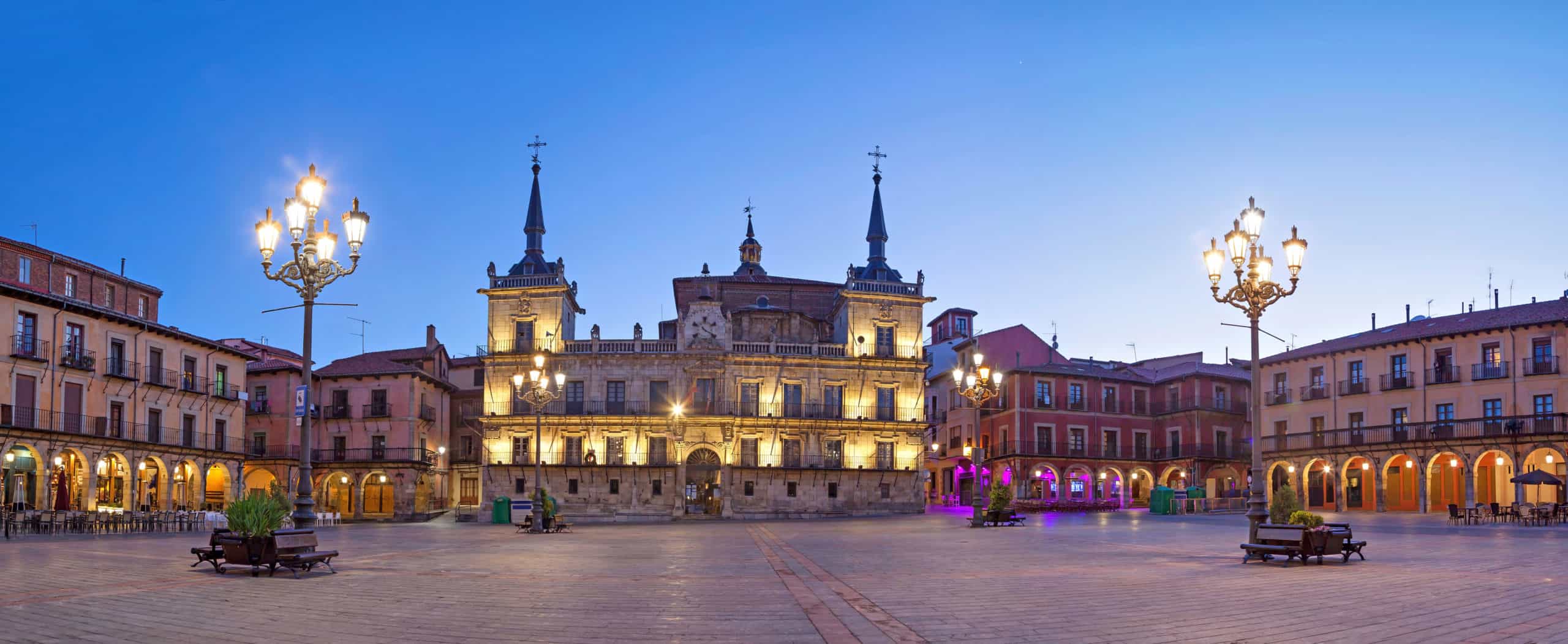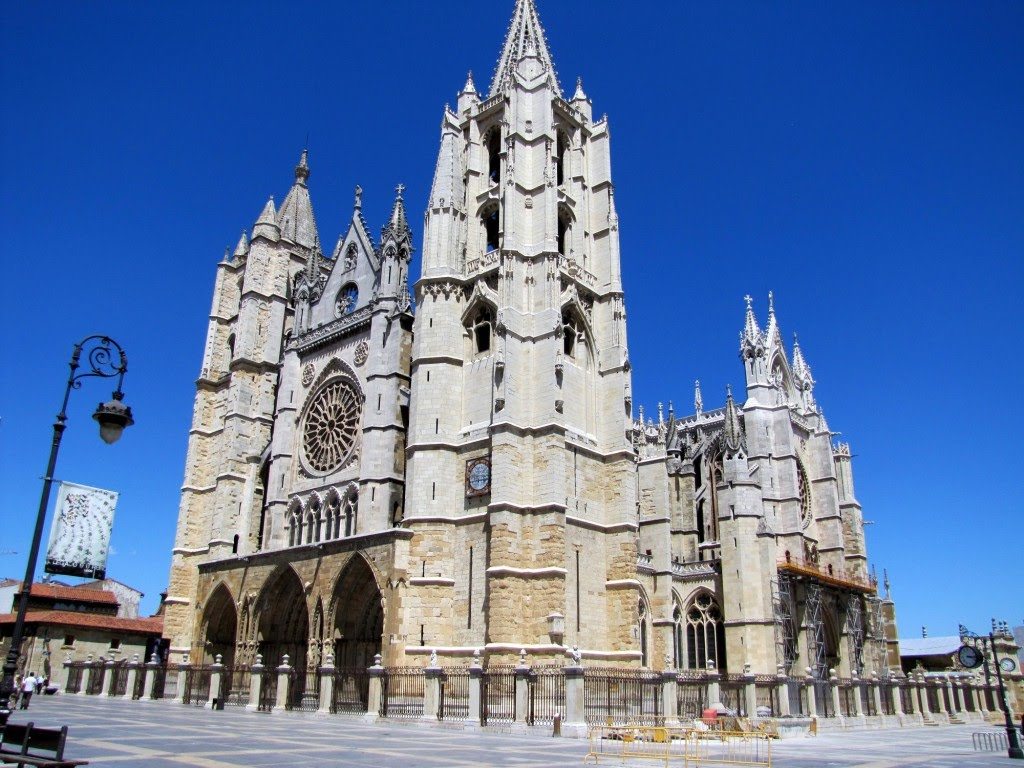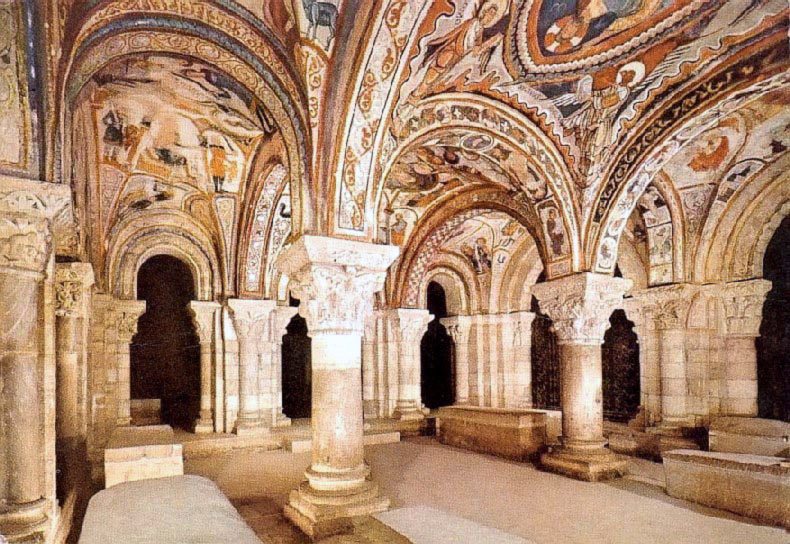To judge by the first sight of its outskirts, Leon, in northern Spain, is like any other modern Spanish city: a few smoke-belching factories and a crop of ugly apartment blocks. But as you move nearer to the older heart of the city, there is an increasing sense of excitement: you begin to realize that you are on the threshold of something special. You may catch a glimpse of the cathedral, you may take a wrong turn and find yourself nosing up a tiny one-way street past ancient houses and through marvelous arcaded squares that are reminiscent of Venice.
If you are lucky, your ultimate destination in Leon will be the San Marcos Hostal, a Parador hotel that will take your breath away with its serene magnificence, but like most pilgrims, you will likely be staying in one of the many albergues or hostels. But whether you stay or simply pass through, your visit to Leon will be one to treasure.
There are two Tourist Offices in Leon, one at Plaza San Marcelo and the other at Plaza de Regla, 2 – http://www.turisleon.com/es/ Both will provide you with city maps and information. The second of the two is opposite the Cathedral.
Related:
What to see in Leon
Of the treasures to see in Leon, the first three below are the most important. If you have little time they are in order of importance and the Camino Frances goes right past the Cathedral; about two hours to fully see each would be needed, but of course you can view quicker.
Leon Cathedral – When the guide book compares Leon cathedral to Chartres, it sounds a little too much like journalistic hyperbole. Leon’s cathedral might be impressive, but as good as Chartres? At first glimpse, the cathedral cannot match Chartres’ massive airship-hangar bulk. But once through the remarkable portals, the point of the comparison becomes clear. The stained-glass windows produce a breath taking swirl of color. The guide-books tell you that the cathedral has 125 windows and 57 oculi producing an area of glass totaling 1,200 square meters — in fact, so much glass and so little wall that the cathedral is in danger of collapsing. But nothing can prepare you for their full dramatic effect. Leon cathedral is unique in Spain, for its windows as, much as for its clean-cut elegance.
The first church erected on this site was in 924, the current Gothic church is the fourth which was started in 1205 and is mostly a copy of the cathedral at Rheims planned by Bishop Manrique de Lara and the foundations were first started by Bishop Martin Rodriguez el Zamorano whose tomb is inside. The finances around the build are interesting: Alfonso X contributed handsomely it is said as his father, Fernando III, had not repaid a loan to the Pope used to reconquer Seville. The papacy granted indulgences to contributors, stopped Italian creditors collecting monies, and signed over a third of their tithes from rural Leon. In 1258 a church in Madrid offered 40 day indulgences to large contributors and two chapels, Santiago and San Clemente, were offered to the highest bidders. Because of this sustained drive to raise funds, the cathedral was built in record time, and by 1302 was complete. During the 15th century Renaissance tastes influenced some rebuilding and additions, for example, the library was built during this period by Juan de Badajoz the Elder, also the sacristy, several portals, and a new arch to connect the cloister with the cathedral. However, the cathedral still retains it 13th century Gothic structure.
The inside of the cathedral is best viewed in the early morning or later afternoon when the sun moves quicker across the floor and walls as it illustrates the colors from rose stained glass windows. Leon cathedral was known as the cathedral without walls, as it has more glass and less stone as walls than any other cathedral in Spain. Guide books can be purchased at the entrance.
Mass times: 9, 12, 13, 18 daily, Sunday: 9, 11, 12, 13, 14, 18 During mass the cathedral is closed to tourism.
During the summer the cathedral is open from 9.30 to 13.30 and 16.00 to 20.00 the entrance is 5 euro, there are no discounts to pilgrims, but attending mass is free.
Basilica of San Isidoro – San Isidoro is built into the old city walls, an impressive chunk of which can still be seen behind the basilica. The Royal Pantheon and Treasury, whose entrance is to the left of the church, contain some exceptional 12th century frescoes illustrating New Testament, hunting and pastoral scenes. The Basilica is five minutes walk from the cathedral, guided tours are available and the entrance cost is 5 euro. Opening times during the months July to Sep are 9am to 9pm, and 10am to 2pm and 4pm to 7pm the rest of the year.
The Basilica was built on a Roman Temple to Mercury, which had been replaced by a monastery dedicated to San Juan Bautista, however, that was destroyed at the end of the 10th century by the Moor invasion. The current church is of 11th century construction and was the most important church in northwest Spain as it established the artistic Romanesque models used in the northern half of Spain. The church was enlarged by Princess Urraca during the 11th century, the portico and crypt were preserved and remain original.
Inside there is an interesting inscription on the baptismal font from Pedro Deustamben who takes credit for rebuilding the church and miracles that happened through him as he was such a great person – it is odd.
San Marcos Monastery – The magnificent 100-metre facade of San Marcos Monastery barely prepares you for its even more astonishing interior. As this is the best hotel in Leon and certainly one of the five best in Spain, suffice to say that even if you aren’t fortunate enough to stay here, you should certainly visit San Marcos both to enjoy its sumptuous elegance and to see the small but touchingly beautiful 11th-century ivory Carrizo Crucifix displayed in the archaeological museum.
The History of Leon
Leon was originally a Roman settlement and fort. There is some debate about who the founder was, most says it was Galba who formed a garrison here from Iberian contingents, the Legio VII Gemina – the Seventh Legion. Galba had one of the shortest periods as Roman Emperor, seven months, over 68 and 69 AD and was assassinated in January 69AD. The area stayed in Roman hand until the fifth century when the Suevi captured it. The Suevi were an independent part of the Visigoths; the King of the Visigoths Leovigildo defeated the Suevi and Leon became part of his kingdom until 712 when it was captured by the Moor leader Muza. Leon remained in Moor hands until it was taken by Ordono Iof Astrurias around 846.
Ordono and his successor Alfonso III rebuilt the city and constructed several churches, Alfonso also welcomed Mozarabic refugees, (Christians that lived under Moors that did not convert). Ordono II the son of Alfonso III, in 914, made Leon the capital of Asturias and Leon by transferring the Asturian court to Leon; he also built a royal palace and deeded the site of the old Roman baths to Bishop Fruminio where the cathedral now stands. The city was once again devastated in 988 by the invasion of Moors under Almanzor and reconquered by Alfonso V of Leon in 999. However, during the 10th and 11th century it is said the Kings were weak and ruled only after paying protection money to the Cordoban caliphs; the name of two of the kings certainly give this impression: Sancho I the Fat and the hunchback Orduno IV the Evil.
Due to these wars, nothing remains of the 10th century buildings. However in the 11th century, Alfonso rebuilt the city walls, then Fernando I persuaded the Moors to release the bones of the Visigoth Saint Isidoro from Seville and a major monastery was built to house them. Leon thereafter grew as the main market and Christian religious center in Northern Spain. The city had a Moorish district centered around Plaza de Santa, as we have seen in other areas most of the Moors living in Christian communities worked in construction trades. After the destruction of the Jewish district at Puente Castro a new district grew in the area south of Plaza Mayor; many of the Jews were farmers until 1293 when Sancho IV decreed that Jews could not own land, twenty years later they were forced to identify themselves by wearing a yellow badge on their clothes.
As with other areas in Northern Spain Leon became less important during the 14th century as Andalucia became Christian and the royal courts moved south. The move of the political influence south, failure of crops which caused famine, and the bubonic plague from 1349 brought to an end the boom times, decimated Leon and slaughtered and depopulated the region. Stability and slow growth did not return until the 15th century after years of political infighting and armed conflict within the Castillian Crown.
Nearby
Puerto de Pajares N, 60km by road – For those traveling south to Leon from Oviedo, the build-up is suitably dramatic, particularly if you have elected to forgo the comforts of the motorway and instead take the old road up through the Pajares pass. Happily, the motorway seems to have filtered off the heavy traffic, leaving the mountain drive free and easy for the tourist.
The early stages from Oviedo take you through rough, untidy coal-mining areas, where mighty slag-heaps and dark satanic mills scar the countryside. (It’s remarkably similar to the Welsh mining valleys.) But after leaving Campomanes, the road begins to climb into the mountains, offering spectacular views at every turn. During the autumn, when the sweet chestnuts, ash and oak trees change color, the lower slopes of the hills are ablaze with red and gold.
At the very top of the Pajares pass (1379m) stands a Parador, closed down and looking sadly forlorn now that it’s by-passed by the motorway, but you can park here and look back down the road you have just climbed and over the jumble of mountain peaks. The drive down the other side of the mountains towards Leon is quick and easy. The change in the countryside is striking; the verdant hills are now replaced by scorched wheat fields. Even when the weather on the Oviedo side is overcast and chilly, here the sun may be burning hot.
Astorga SW, 50km by road. – The next major stop after Leon for the pilgrims on their way to Santiago de Compostela, Astorga was well known for the excellence of its fairs. Set in pretty, verdant countryside, the city is worth visiting for its cathedral and a bizarre episcopal palace, which looks like Sleeping Beauty’s castle and was built in 1889 by Antonio Gaudi, best known for his outstanding architectural work in Barcelona. The town is also famous for the Maragatos people who live in the surrounding countryside; they are a reclusive race believed to be descended from Berbers and Visigoths — you may be fortunate enough to see some in the town dressed in their distinctive costume (men in baggy trousers and women in brightly coloured shawls and full skirts).
Valporquero Caves N, 35km by road. – Dramatic formations of stalactites — including a stalactite star; all stained an extraordinary variety of colors and tones by the mineral oxides in the stone.
Where to stay in Leon
San Marcos Hostal – Unless you’re exceptionally well informed on these things, you probably won’t have heard of Leon’s San Marcos hotel. Once you’ve seen it, you’re unlikely ever to forget it. Its official category is five-star grande luxe and Michelin gives it a rating of five red gables and this in an area where any red rating is noteworthy. Classifications and categorisations are pitifully inadequate when it comes to conveying the attraction of the San Marcos. One writer describes it as one of the five best hotels in the world. You would have to agree with that, but the San Marcos is more than simply a hotel, it is an experience — for a night or two you are allowed to indulge yourself in magnificence.
There may be some hotels that offer greater luxury than the San Marcos; there are few that can match it for style and grandeur. The core of the hotel is a 12th-century monastery where soldier friars helped protect pilgrims on the way to Santiago de Compostela. (The hotel’s chambermaids are dressed in what look like nurses’ uniforms, presumably in the tradition of the hotel’s role as a pilgrim’s hospital.) The foyer is a large hall decorated with paintings and other art treasures; large windows reveal delightful cloisters filled with sculptures and a variety of Roman archaeological discoveries. For other hotels and cheaper pension accommodation it is better to check booking.com or hotels.com for availability.

I love hiking, backpacking, and camping. From the Camino de Santiago to the West Highland Way in Scotland or simply a great day hike on the weekend. Hiking refreshes me, my mind, and keeps my body reasonably fit. So far I have walked three Camino routes and many other long distance hikes in the UK, Canada, and around the rest of Europe. One of the best was my hike up Ben Nevis.



